Review: Nokia Lumia 1020
We've had the chance to look over the AT&T branded version of the Lumia 1020 over the last week. We'll have more coverage over the next few weeks, but to start we're going to look at the hardware of the 1020 - not just the PureView branded camera, but the materials and design, screen technology, and other internals. The Lumia 1020 ships with the GDR2 release of Windows Phone, and we'll look at that separately, but the critical software additions Nokia have added to the 1020 will feature as we deliver a verdict on the 1020. Is it all about the camera, or does the 1020 have more to offer than a pretty picture?
Buy Link | Download / Information Link
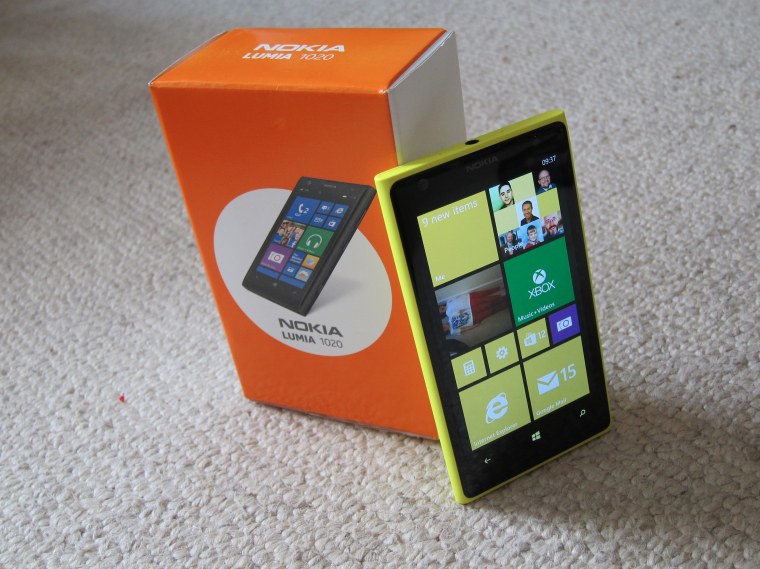
Introduction
Nokia have had a good run of phones in the last few months. Sales are solid, if not spectacular, and while the sales of the low-end Lumia 520 are probably more strategic and having a bigger impact on the market share numbers, the high end platform of the now venerable 920 and the new variants of the 925 and 928 have caught critical acclaim. When the world's media were invited to the Lumia 920 launch, the question was still 'would Nokia survive?' Six months later, the questioning seems to have moved on to ask 'how big will Nokia end up?'
And then the Lumia 1020 arrives. The AAWP team have followed Nokia for a long time, through many iterations of their operating systems (and in fact through many changes of operating systems), so it was a bit of a surprise as we took in the shock of journalists and the sudden awe that Nokia's 41 megapixel yellow monster generated. We knew all along what the Finnish company were capable of... suddenly the rest of the mainstream world remembered.
I think it would be fair to say that Nokia are back up to speed after the switch from Symbian to Windows Phone. The smartphone world has changed around them, so is Nokia's best enough to match the competition?

In the box
AT&T have packaged the Lumia 1020 into their own style of packaging, with a portrait orientated flipbox in the corporate orange and white colours, the AT&T logo on the top and a rather bland 1020 image on the base. Laminated cardboard is throughout, with numerous leaflets to get through before the phone is discovered.
A fold out quick start guide is included, which covers the basics of Windows Phone 8, including navigation, social network integration, HERE navigation services, AT&T's own software services, and of course the Pro Camera app. The regulatory product and safety information booklet is as plain and boring as you would expect.
There's some nice positioning with three flyers - one for a free poster from an image (20x30, but there's no note if that's metric or imperial measurements), a note card that explains that the Lumia 1020 camera will make some strange noises when taking pictures ("that's the sound of blur-free photos and super-stable videos", referring to the OIS mechanism), and a flyer with an NFC chip that takes you to a website that will give you a guide to taking great photos.

Accessories wise, there's the Nokia charging and data USB cable (CA-190CD), a wrist strap, and a SIM door key so you don't need to hunt for a paperclip. You will need to hunt for headphones, although for me personally that's not an issue as it's been a long time since I've relied on my on headphones rather than the ones thrown in the box to make up a bullet point on the spec list.
The 1020 itself has two protective plastic sheets gently stuck to the handset, with the rear one pointing out the functions of each button, and a screen protector asking you not to text and drive - a campaign that AT&T have been heavily behind for some years now.

Design and Materials
The Lumia 1020 continues Nokia's use of the 'Fabula' design style that has been evident on the high-end 'flagship' Windows Phone handsets, reaching back to the Lumia 800 (and arguably the Symbian-powered N8 cameraphone). Staying with the flat ends on the short top and bottom edges, the rounded ends on the longer edges and the blending of the curved glass screen, gives the 1020 continuity of design with the 920, 900, and 800, allowing the handset to both stand out against other manufacturers but also able to say through design that this is a Nokia.
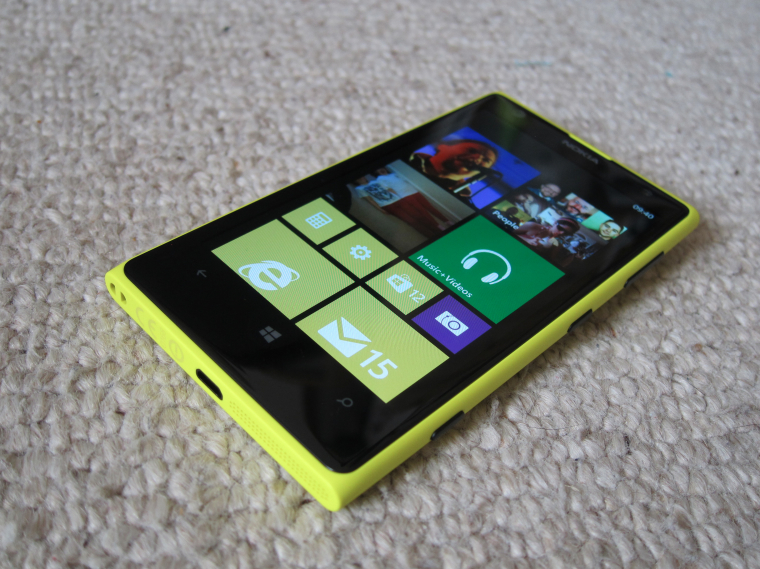
Unlike the 920, which had a central bulge running down the length of the back casing, the rear of the 1020 is parallel with the front, at least on the bottom - at the top is a circular protusion with the various camera elements that make up the 41 megapixel unit, the main lens, an LED light to aid focusing, and the Xenon flash unit. Highlighted in a raised black circular disc, the main casing reaches up with a comfortable sweep to meet the black. Not only does it highlight the camera unit, it's also comfortable. Holding the 1020 in my hand, the camera lip sits on top of my middle finger and helps secure a large handset that I would otherwise worry would slip out of my hand.
The polycarbonate casing allows the strong use of colours throughout the plastic, although only three colours of handset are currently available - the expected white and black, and the distinctive yellow that is being pushed at every opportunity in the media. As with the 9xx handsets, the colour is integral to the plastic, so scratches will be less noticable as there is no base colour under the top - if you have a yellow 1020, it's yellow through and through.
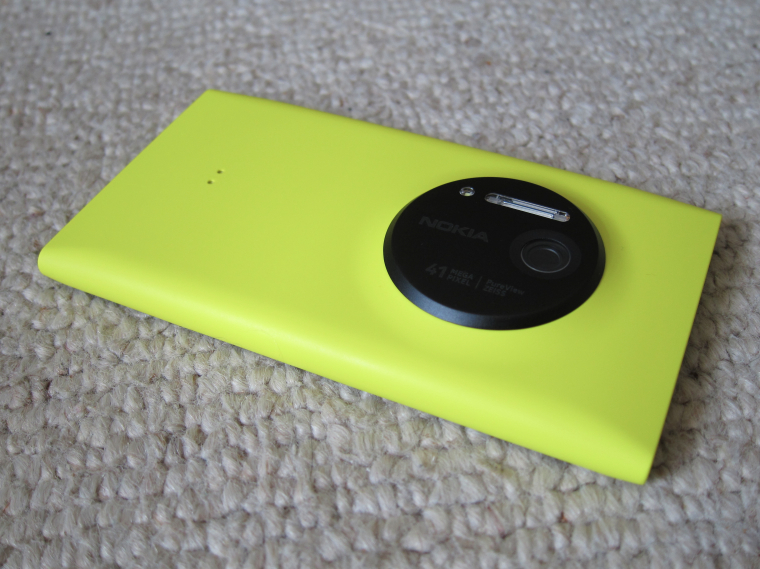
The SIM tray for the 1020 is on the top of the unit, and with a SIM door tool in the box it should be no surprise that it sits flush with the top of the unit, spoiling as few of the designer lines as possible. The 3.5mm audio jack remains in the centre of the unit, while the microUSB port is at the bottom of the unit. Also on the bottom is the lanyard port for the addition of the wrist strap. This has been a noticeable omission from previous Nokia handsets, but given the targeting of the 1020 as 'camera first', the addition of a wrist-strap is something that is expected by a photographer. A small touch, but it's all about positioning the handset in the mindset of the buyer.
The screen is biased to the top of the device, with a smaller top bezel featuring just the Nokia logo (now dead centre) and the AT&T globe on the left, symmetrical with the front facing camera.
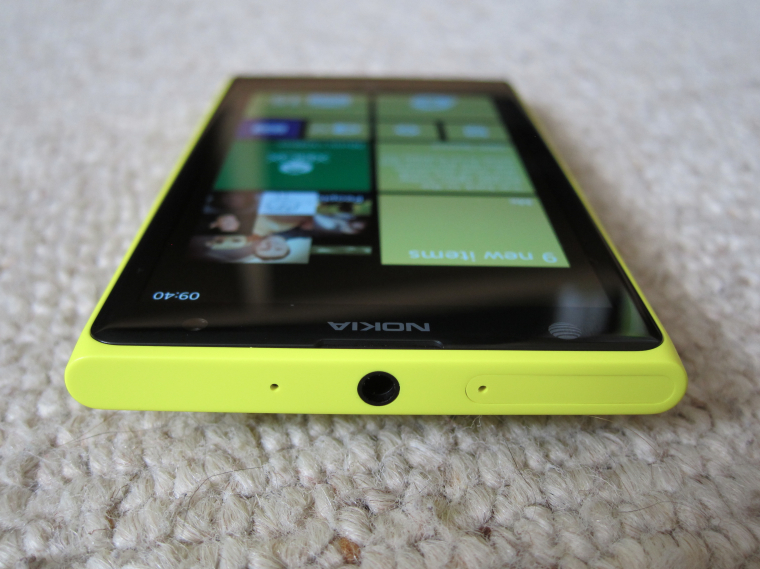
Nokia have switched to anodised aluminium for the camera fascia and the standard Windows Phone buttons on right edge of the handset. How well this stands up to day-to-day use compared to the previously the ceramics used on the Lumia 920 remains to be seen, but it's certainly going to be better than the plastics used on the first generation of Lumia handsets. The buttons themselves have a good positive action, with the two stage camera capture button feeling like it has better tactile feedback than previous Lumia models.
Even with the reworking of the camera hardware for more functionality in a smaller form factor, stacking and building the components for a better profile, fitting everything into the 1020 is an impressive task. Don't forget that the handset still packs in NFC, 4G aerials, a 2000 mAh battery, and everything else you expect in a modern high-end handset. That's not easy, and even with the sacrifice of wireless charging to a third party shell, the thinness of the 1020's profile is impressive. Looking at how other handsets have coped with a large camera, the design of the 1020 is the best in the business.
Size and weight
There's no doubt that the Lumia 1020 is a big handset - the size of the camera unit takes the thickness of the handset out to 14.5 mm, although the spec sheets rate it at 10.4 mm, which is the thickness of the handset over the rest of the back. That's slightly thinner than the Lumia 920 (10.7mm) although the trend for thin devices mean the 1020 is almost twice as thick as the Samsung Galaxy S4 (7.9 mm). It seems strange to trade a millimetre here and there, but welcome to the modern design battle.
| Device | Size (mm) | Volume (cc) | Weight (g) |
| Lumia 1020 | 130.4 x 71.4 x 10.4 (14.5) | 96.9 | 158 |
| Lumia 928 | 133.0 x 68.9 x 10.1 |
92.75 | 162 |
| Lumia 925 | 129 x 70.6 x 8.5 | 78 | 139 |
| Lumia 920 | 130.0 x 70.8 x 10.7 | 99 | 185 |
| Lumia 900 |
127.8 x 68.5 x 11.5 |
90 | 160 |
| HTC 8X | 132.4 x 66.2 x 10.1 | 86 | 130 |
| HTC One X | 134.4 x 69.9 x 8.9 | 84.4 | 130 |
| HTC One | 137 x 68.2 x 9.3 | 87 | 143 |
| Samsung Galaxy S III | 136.6 x 70.6 x 8.6 | 82.2 | 133 |
| Samsung Galaxy S IV | 136.6 x 69.8 x 7.9 | 76 | 130 |
| Apple iPhone 5 | 123.8 x 58.6 x 7.6 | 76 | 112 |
I've never been a big believer in 'thin', so this part of the Lumia 1020 review is lost on me. It's as thin as it can be, and the extra few millimetres make the handset feel stronger and better constructed in my hand - this phone can survive being in my trouser pocket - something I was never confident about with the SGS4.
At 158 grams, the Lumai 1020 has some heft to it as well. In modern reviews, I believe this is the point where I have to write "I'd better take up some arm strengthening exercise to carry this phone", but again, the quest for a smaller number in the physical properties has not been kind to modern smartphone designers. The Lumia 1020 is in fact lighter than the first Windows Phone PureView camera phone (Lumia 920, 185g), and is also even lighter than the Lumia 900 (160g).
Again, much like the styling, you have to consider what the team had to put into the handset to appreciate just how much of a challenge it was to keep the metrics in the same envelope as less capable camera-focused smartphones.
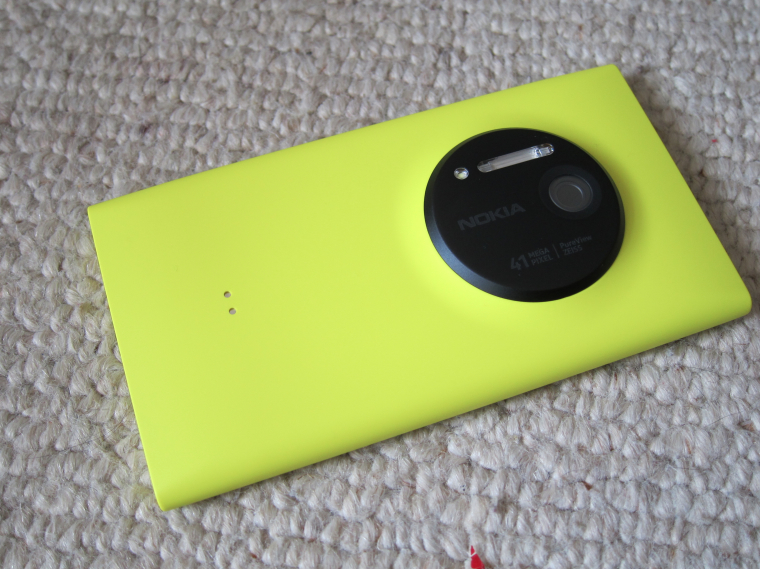
While Windows Phone as a UI might be set up for a one-handed interface, the size of the 1020 puts paid to this idea, with my thumb unable to reach the top right corner in one handed mode. Thats nothing new on the 4.5 inch-screened Windows Phone, and the quest for one-handed-ness seems to have been given up by every major smartphone manufacturer, at least in the high end handsets.
One surprise from me is how little the size change is reflected when you look at the front of the device. When you can't see the bulge, the Lumia 1020 is easily mistaken for a regular large screened Windows Phone. In fact the bulge actually helps, as it gives a tiny slant to the handset so it is facing ever so slightly towards you as you lay it down. Not only does this keep the camera glass away from the surface, it makes the 1020 cry out for a little more attention when it's on a desk.
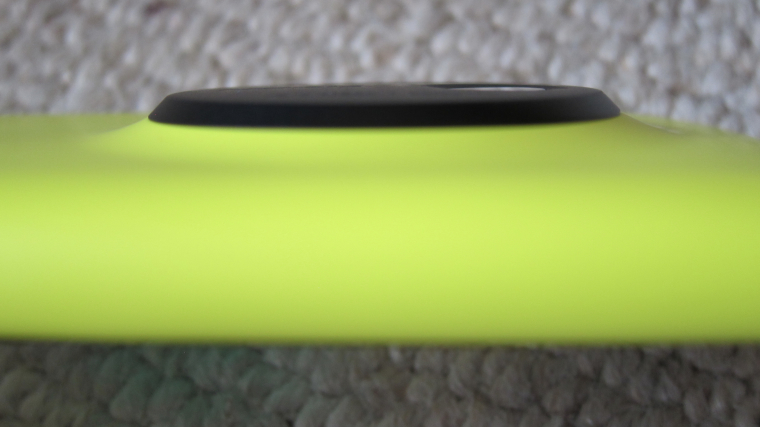
You're not going to buy a Nokia 1020 for its profile. While Nokia have (admirably) worked to keep the profile as small as possible, this is a handset that is not going to let itself go on a diet just because everyone else is doing the same. The advertising slogan says it wants to "reinvent the cameraphone" and that does require a lot of technology, and in the case of the physics, a certain amount of distance and size in the lens and sensor assembly. I'll point out the Galaxy S4 again as a handset that compromises a lot to get into physical shape - the Lumia 1020 is about getting the best camera in the most capable smartphone. Everything is packed in here, and it's lighter than Nokia's previous camera flagships.
When we reviewed the Lumia 920, we were conscious that it did feel a little heavier than expected, but not outlandishly so. I would have expected the 1020 to be heavier, but it's not. Perhaps we'll see a teardown on the unit to find out why, but the conclusion is this - Nokia have done a superb job in designing the internals to stay in touch with the expectations of the fashionistas without hampering the focus on the PureView camera.
The target market is not going to discard the Lumia 1020 because it's over 150g, and for those who are on the fence the choice is a simple one - weight or camera. I think a lot of people will choose the camera (for everyone else, the Lumia 925 clocks in at 139g). The same argument goes for the camera bulge, the photographer is going to jump on the specs and quality, and everyone else can choose between profile (the aforementioned Lumia 925) or the camera.
Screen
The Lumia 1020 sports a 4.5" AMOLED screen, running at 1280x768 pixels (I'll save you the maths, it's 332 ppi, which is comfortably more than Steve Jobs' definition of a retina display). Using Gorilla Glass 3, it's one of the strongest screens out there, and it looks fabulous.
Most of that is down to Nokia's screen technology, all of which is used in the display. The oldest element of this is the ClearBlack display, which uses two polarized layers to reduce glare in sunlight and increase the contrast of the colours. In practice, this means that blacks are 'more black' than on a regular display, and colours 'pop' out of the screen with a lot of vibrancy and contrast.

Nokia have also set up the screen to respond with more brightness when in direct sunlight and bright environments by switching the backlight to a high luminance mode to outshine the ambient light while adjusting the contrast levels to adapt for the conditions. It's never an issue with the rain of a Scottish summer, but it's very much appreciated when the sun does come out (or I visit Texas).
The 1020 also uses the PureMotion HD+ technologies announced alongside the 920. The refresh rate is increased to 60Hz through clever use of technology. Part of this is down to the graphical horsepower available, but it's also down to the response rate of the pixels. Nokia have used what they call an 'overdrive' mode to get the response rate under 16ms - the speed needed to see the benefits of a 60Hz refresh rate. This was first seen on the LCD screen of the Lumia 920, and Nokia have carried this on to their AMOLED handsets (the 925, 928 and 1020 handsets).
You can see this well on fast moving and graphically rich video games, but it also provides a much smoother look in the Pro Camera application both when composing shots live, but also when manipulating images after taking them, with pan, zoom, and twisting effects all happening smoothly and quickly. It's unlikely the regular consumer will see this in action without a detailed side to side comparison, but the simple feeling of 'this is a good screen' is there.


Super Sensitive Touch is also present, and it's one of the few times that a party trick has a clear real-world use. Pop on the thickest, chunkiest, pair of gloves you can find, and you'll still be able to use the touchscreen of the Lumia 1020. It's another small checkbox in the technology that Nokia packs into their phones that has become de rigeur for those paying close attention, but magical to everyone else. This is where testing the phone in Texas would miss something that's vital to those used to colder climates, be it the summer rainstorm of Scotland, or the snowy heights of Alps on an executive break. I'm surprised more manufacturers haven't caught up with this touchscreen trick yet.
Glance mode is also available, allowing you to take advantage of the low power draw of the AMOLED screen technology and have the time always available for you to see. Strictly speaking it's not always-on, as the display can time out, and will shut diwn if it reckons the phone has been put in your pocket, but unless you sneak up on it, you'll have the time on display. Again, a small thing, but one that has proven incredibly useful on other handsets from Nokia (admittedly Symbian powered, but the functionality is the same). I especially liked the idea that you could set a 'Night Mode' time window when the display is still there, but dimmer (and atmospherically in red, so you can pretend your bedroom at night is really a submarine).
All of these technologies have been seen before, and notably replicated in the Lumia 925 and/or 928, but they're still stunning. In terms of the visuals, the screen on the Lumia 1020 is one of the best, and really delivers.
Camera
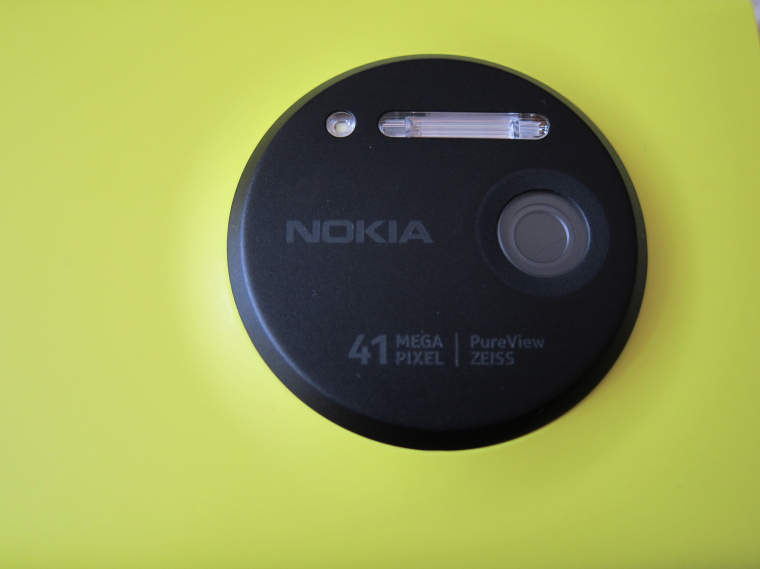
This being the central unique selling point of the Lumia 1020, we'll of course give this a featured review of its own. Suffice it to say that the 1/1.5" 41MP BSI sensor, allied to some genuinely innovative zooming and framing software, is a generation ahead of anything else in the phone camera world (aside from its sister on the older Symbian platform, the arguably obsolete Nokia 808, which has a bigger sensor but significantly less flexible interface and composition software).
The extra sensor size means potentially higher detail in good light and lower noise in low light, while the Xenon flash ensures great 'people' shots indoors and in the evenings. All the while, with the flexibility to shoot a scene first without thinking too hard about subject and then reframe or zoom in later on, after the fact.
Both stills and video capture benefit from the presence of second generation Optical Image Stabilisation, involving ball bearing mounts and tiny actuators, still in a barrel shift configuration and with full 3-axis response (unlike the limited OIS implemented by other camera phone manufacturers). 1080p video is thus spectacular and cinematic in quality, aided by the same stereo HAAC microphones as the Nokia 808 PureView (and implemented in mono in the 920), of which more below.
We'll be testing the Lumia 1020's camera in detail for a separate feature later this week, here on All About Windows Phone.
Audio
It's been a long time since audio quality out of any modern smartphone could be called poor, the technology has been maturing for some time, and you'll actually have more flaws from the lossy MP3 encoding of your music than through the audio components. That said, there is still a difference between the first generation Windows Phone devices and the Lumia 1020, and the 1020 is the better handset here. The choice to not include a headset in the box means people with good quality headphones to listen to music will naturally default to them, while everyone else will have a nice pair of in-ear headphones from the local supermarket - so you'll get the quality you plan for.
Nokia have bundled some nice additions for the audiophile as part of their standard package - a graphic equaliser with a generous selection of presets - and if they don't suit you just slide the bars up and down on the touchscreen that represent the seven channels. You can also switch on a Dolby Digital filter when listening on headphones, and a useful audio 'leveller' which ensures that all your music playing has the same RMS decibel level (i.e. they'll all sound like they have the same volume, so there are no drastic swings between tracks).
Unfortunately, these audio choices are tucked away in the 'settings' application, and not easily accessible from the built in music application - but it is at least an option in the Nokia Music app.
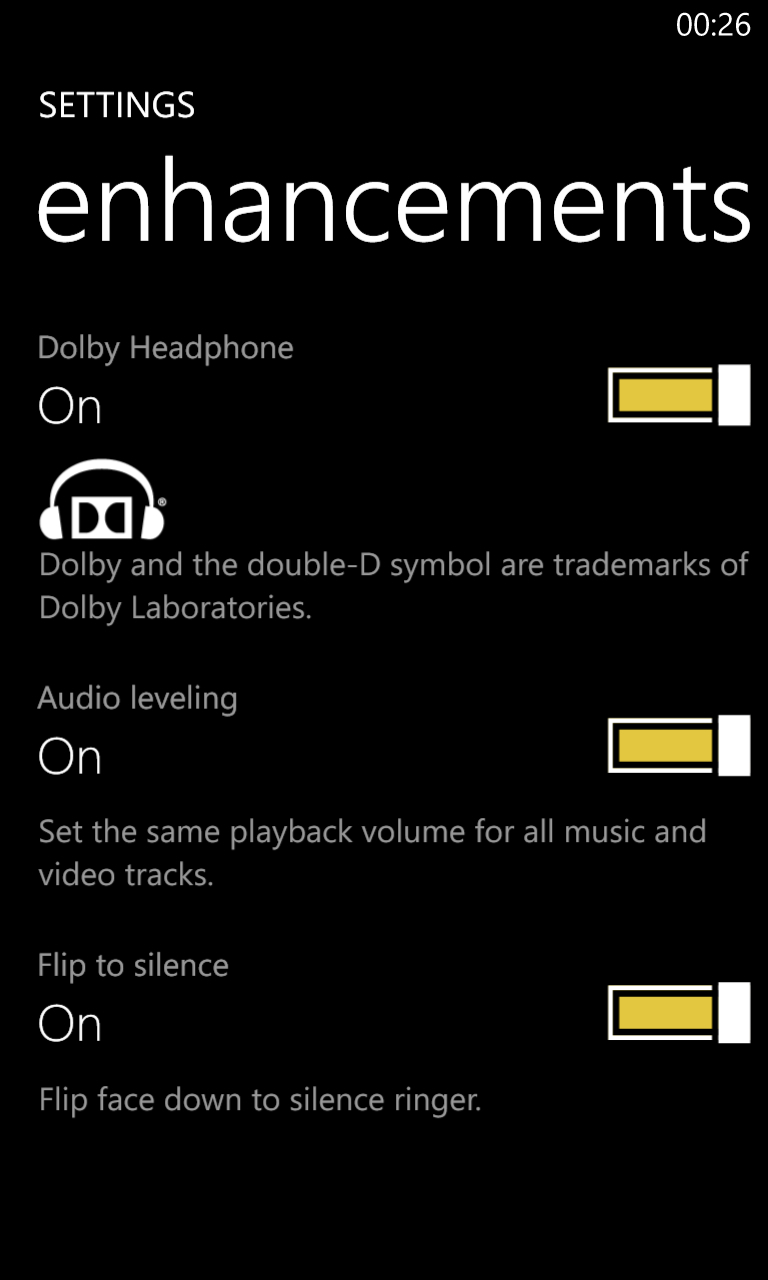
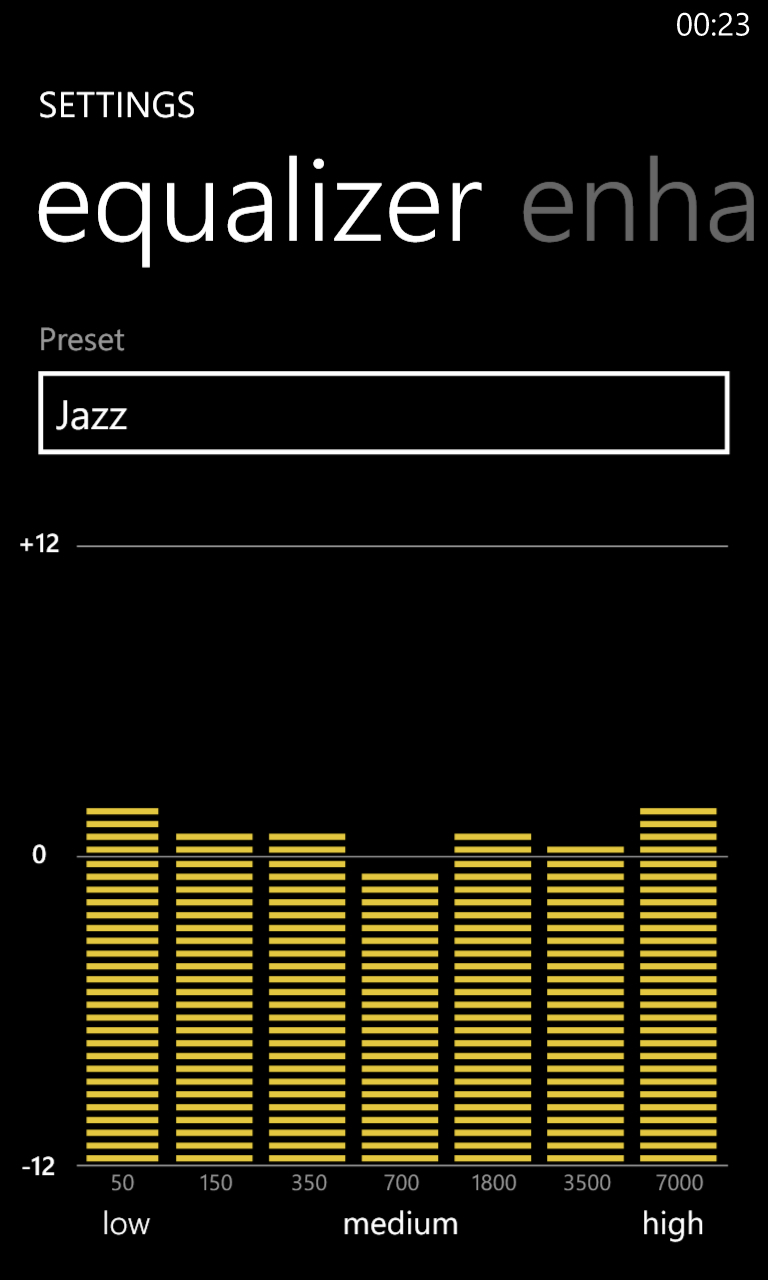
Switching away from headphones, the mono loudspeaker, which has a machined grille on the base of the handset, is adequate. It has a decent amount of volume output, but it feels more suited to speakerphone calls than music reproduction. I find it strange that the graphic equaliser is disabled when using the speaker, as altering the tone of the music when played out loud would seem to be exactly when you would need this sort of function.
Audio capture though, is another matter. Nokia's High Amplitude Audio Capture (HAAC) microphones are present. Not only are they able to capture a wide frequency range, but the microphones and the audio processing allow them to handle loud environments (up to 140 dB) with ease - capturing live moments in a rock concert is easier on the 1020, with much clearer sound reproduction. It rivals many consumer HD video recorders, and coupling the HAAC microphones with the video shooting capabilities of the 1020 gives you an 'always with you' video recorder that delivers excellent results.
Those with experience of the Lumia 920 and it mono audio recording capability will be glad to know that the Lumia 1020 will record in stereo when using Nokia's Pro Camera app. The Lumia 920 will get this capability, and the Pro Camera software itself, in a software update, but for now both are Lumia 1020 only feature.
The HAAC microphones also work together during phone calls to pick up both your voice clearly, but also to act as a noise cancelling system for ambient sounds.
Internals and performance
The Lumia 1020 is built around a system on a chip design from Qualcomm, specifically a Snapdragon S4. The dual core Krait processor is clocked at 1.5GHz,with the Adreno 225 acting as a graphics co-processor. In one of the few hardware changes from the Lumia 925 and Lumia 928, the Lumia 1020 comes with 2GB of RAM. The increase is to support the processing of the high megapixel images generated by the PureView camera, but the benefits of the increased RAM show up in other intensive areas, notably when browsing very large web pages (I'm looking at The Verge as an example here) and in graphically rich gaming, such as Modern Warfare or Halo: Spartan Assault.
It shouldn't be a surprise that the Lumia 1020's WP Bench score matches its hardware brothers, e.g. the Lumia 925. Windows Phone 8 is streets ahead of the Windows Phone 7 devices (the higher Lumia devices running WP7 score around 90 on WP Bench).
Windows Phone is a very efficient operating system, which helps at the low end, but when you give it lots of high-end specifications to go wild with, it's fast, smooth, and a joy to use. There's nothing to fault in the hardware implementation of the Lumia 1020 in terms of basic smartphone functionality.

Onboard storage of the AT&T branded Lumia 1020 is 32GB, with no support for microSD cards. While there are rumours of a 64GB version coming to another carrier nearer September, the question of 32GB and 'is it enough?' is a tricky one to answer. This is a handset that demands a lot of pictures being taken, and with the two images in the handset each time, each pic takes up around 15-20 MB. Yes, that does add up, but at the same time I would expect photographers to be regularly backing up their pictures. I'll refer back to Steve's discussion on a recent AAWP podcast - with the Lumia 920 he would happily take lots of pictures and videos, and never fill the 32GB of the handset. In the real world, it seems that 32GB is more than enough - it's just people looking to find some negatives that find the microSD support issue an easy target.
I'm tempted to trust Steve's judgement on this one and say it could easily be a non-issue, but your personal mileage (or is that storage) will vary?
And yes, you do get 7GB of SkyDrive storage when you pick up a handset - though it would be nice for picture backup and upload to also save the big megapixel image for backup reasons, and not just the resulting 5 megapixel output(s).
The Lumia 1020 is tricked out with all the currently fashionable sensors. A-GPS and A-GLONASS are available for positioning data, a magnetometer will find north (and assist the gyros and accelerometers to derive the orientation of the device). Nokia also lists a barometer in the spec sheet as well, but I've not found an app that makes direct use of the pressure sensor. As previously mentioned, an ambient light sensor is on the front of the unit, which also sports a 1280x960 front facing camera for selfies, Skype, and video calling. This uses a wide angle lens to capture a decent field of view - two or three people video calling home are easily accommodated within the field of the f/2.4 lens.
NFC is included inside the casing, both for Tap+Send between NFC enabled Windows Phone handsets, but also as part of Microsoft's 'Wallet' app for contactless payments and ticket processing. It's also used to enable easy pairing with Nokia's NFC equipped Bluetooth accessories.
Bluetooth 3.0 is used with a number of profiles available for peripherals and connectivity:
- Object Push profile (OPP) 1.1, Hands-free profile (HFP) 1.5, Advanced Audio Distribution Profile (A2DP) 1.2, Audio/Video Remote Control Profile (AVRCP) 1.4, Phone Book Access Profile (PBAP) 1.1
Note that these Bluetooth specifications are from Nokia's own site, but there is strong evidence to suggest that Bluetooth 4.0 is already present, or will be added via a software update. It's not something that very relevant right now given there are few, if any, Bluetooth Smart accessories currently supporting Windows Phone.
Wi-Fi supports a/b/g/n, with a number of security modes available that cover the majority of protected Wi-Fi networks, specifically:
- WPA2 (AES/TKIP), WPA, WPA-Personal, WEP, WPA2-Personal, WPA-Enterprise, WPA2-Enterprise, PEAP-MSCHAPv2, EAP-SIM, EAP-AKA
Network support is wide ranging for a world enabled device such as this.
- 2.5G GSM/GPRS/EDGE – 850, 900, 1800, 1900 MHz
- 3G UMTS/DC-HSPA+ – 850, 900, 1900, 2100 MHz
- 4G LTE Rel. 8 (UE Cat 3) – LTE band 2, (1900MHz), 4 (1700/2100MHz), 5 (850MHz) & 17 (700MHz)
As the Lumia 1020 is currently an exclusive with AT&T, we've not been able to test it on European 4G networks, but both a "global" and "China" variant, with appropriate band changes, will be available in due course. Our preview handset identifies itself as model NOKIA 909, which is a clear indication to the heritage of the device, but gives no clues as to upcoming variants. We'll let you know here on All About Windows Phone when we hear how the rest of the world will be served.
Nokia are heavily invested in the Lumia 1020, and they've ensured that the handset is capable of working on the majority of the world's networks - which will help when roaming (at least to get connected, you're on your own in terms of paying for international data roaming).
Battery life and charging
The Lumia 1020 sports an integrated 2,000 mAh battery, identified as the BV-4NW. The capacity matches the Lumia 925 and Lumia 920, and Nokia's spec sheets give a talk time of 19.1 hours GSM ./ 13.3 hours WCDMA, and a maximum standby time of 15 days. That's just 360 hours, which is less than the stated time for the Lumia 920 (450 hours) and the Lumia 925 (440 hours).
Having had the 1020 for less than a week, it's hard to say how this translates into real world use, but the 1020 gets through a day of regular use with little worry and some capacity to spare. Where there is a big power draw is in taking pictures - there's a lot of CPU time being used to process the megapixel images, as well as a lot of information to write to the disk, not to mention the physics of driving the focussing motors and OIS, powering the sensor, etc. A sustained photography session has some serious impact on battery life, and I can see now why the 'camera grip' peripheral sports an extra battery. Physics dictates that this can't really be helped, but it's still a shame that the primary use of the 1020 is so energy intensive. To balance that out, professional DSLR cameras go through batteries rather quickly as well, so this obviously comes with the territory.

Wireless charging has been passed over to an additional jacket, which was not available at the time of this review. Presumably both the wireless Qi charging jacket and the camera jacket make use of the pinpoint exposed contacts on the rear of the handset to supply a stream of power to the main battery inside the 1020.
While many people swear by wireless charging, it's not something I'll miss, given I've never actually used it on the other devices, but for many on the AAWP team, it will be a disappointment that it's not built-in out of the box.
Final Thoughts
It would be very easy to say the Lumia 1020 is nothing more than the Lumia 925 with a better camera (okay, with a much better camera). From a technical point of view that is accurate, but the Lumia 1020 is far more than that.
It's an aspirational device, that says to the world what Nokia is capable of. It says that Nokia are doing things that are not just better than other manufacturers, but that they are years ahead of other manufacturers in certain areas, no matter the mobile platform used. There is no doubt that the PureView camera and resulting pictures taken by the 1020 are nothing short of stunning when compared to other smartphones currently on the high street. When the choice has been to make a better camera, or a more acceptable to the mainstream smartphone, Nokia have ensured the 1020 makes the choice to go down the cameraphone route. If you want to see what happens when you go in the other direction, look at the Lumia 925.
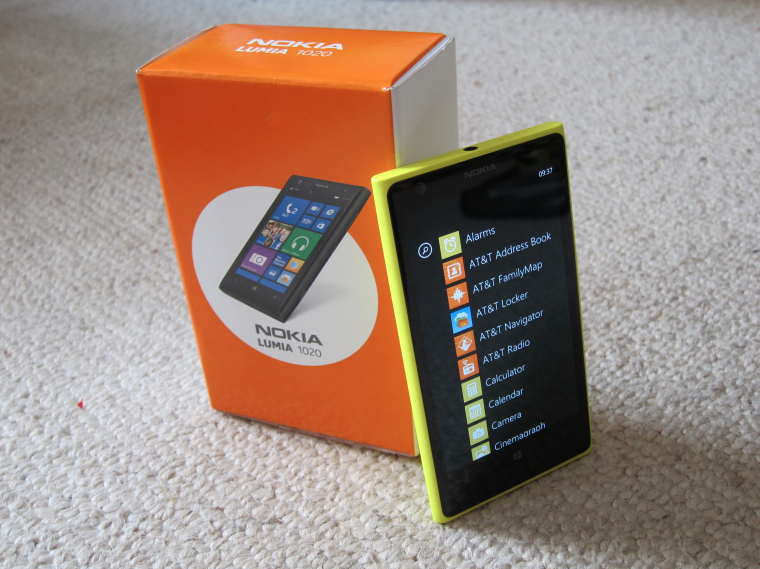
I think in many circumstances the Lumia 925 is actually the better all-rounder. For someone who wants a phone that is 'good enough' then the Lumia 925 can match up favourably to the HTC One, the Samsung Galaxy S4, and the iPhone 5.
But if photography is your thing, and that makes up a significant number of smartphone buyers, the Lumia 1020 changes the landscape dramatically (it's true that the Nokia 808 existed a year before, but with Symbian under the hood, Nokia didn't push it or even sell it in many markets - it was effectively a technology demonstrator).
We're fans of Windows Phone here (the clue is in the site name), but I genuinely believe that the average consumer will be happy with Windows Phone 8 as a mobile operating system. I know it gets short shrift from the geekerati, but that's how I see it. Take that competency and add on to it a camera that gives, frankly, stunning results, and you have a winner.
Will it be a best seller? Perhaps not, I suspect the Lumia 925 will have sell more units by the end of the financial year compared to the Lumia 1020 - but the Lumia 1020 is Nokia's great big, honking, flag waving, trombone playing, message delivering smartphone... "We're back", it screams "and we've got some pictures to prove it."
Continuing coverage of the Nokia Lumia 1020 on All About Windows Phone
Over the next few weeks we're going to put the Lumia 1020 through the wringer. Steve's itching to get his hands on it to do his own comparison shots and get to grips with the new PureView technology, while I want to see just how good the video camera is for recording concerts and gigs (with the Edinburgh Fringe coming up, I think I can find a few opportunities there). Windows Phone 8's GDR2 will also be examined closely, as will Nokia's Amber update across their handset portfolio. We'll be covering all of these, as well as the lighter side of the Lumia 1020, here on All About Windows Phones.
See also
Review: Nokia Lumia 1020 camera - photo capture
The first big PureView battle: Nokia 808 vs Lumia 1020
4 way flagship phone camera shootout: Nokia 808, Lumia 1020 and 925, Galaxy S4 Zoom
Reviewed by Ewan Spence at
